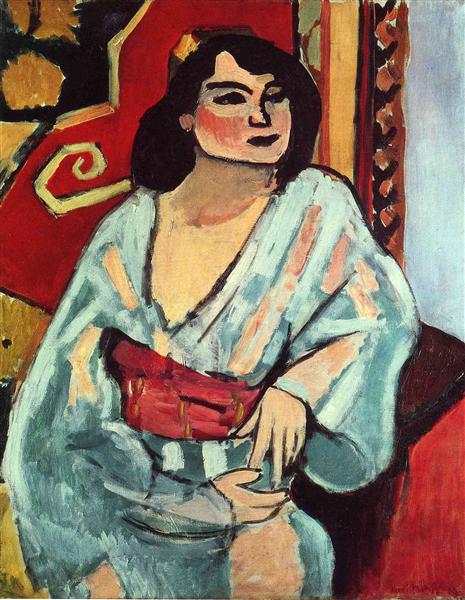Description
Henri Matisse, master undisputed master of color and form, achieves in "Algerian Woman" from 1909 a visual alchemy that captivates and challenges in equal measure. The work, with its dimensions of 47x60, is a window into the formal and chromatic universe that Matisse explored during his Fauvist period, characterized by a bold liberation of color use against the naturalistic conventions of the time.
The painting presents an Algerian woman dressed in traditional attire. Her posture and expression are of contemplative serenity that conveys deep introspection. In terms of composition, Matisse shows his ability to balance dynamism and stillness. The central figure is surrounded by a simple yet vibrant background, which places irresistible emphasis on the woman and her garments.
The use of color in "Algerian Woman" not only serves to describe but becomes the protagonist of the work. Matisse employs a rich and saturated palette: the reds, blues, and greens are arranged in fields of color that seem to move with a life of their own. The technique here is fascinating; the applications of color are broad and bold, with visible brushstrokes that demonstrate exceptional confidence and mastery.
The contrasting play of warm and cool colors in the attire and background suggests a harmonious relationship but also an underlying tension. The areas of flat color, typical of Fauvism, intertwine with softer lines that contour the figure, giving it a sense of three-dimensionality without resorting to traditional chiaroscuro.
Matisse, influenced by his travels and his fascination with the cultures of North Africa, captures something more than the mere physical appearance of the Algerian figure. The work suggests an exotic atmosphere and cultural introspection that transcends simple visual representation. It is in this sense that "Algerian Woman" resonates with a sense of mystery and irresistible allure.
The painting is inscribed in a broader context of Matisse's work during the first third of the 20th century. During this period, the artist was deeply interested in the synthesis of forms and colors, taking abstraction to new levels within figuration. Other works like "The Dance" and "The Music" share this exuberant exploration that defines Matisse's legacy as one of the great innovators of modern art.
Through "Algerian Woman," Matisse not only honors his subject but invites us to a meditation on the depth and inherent beauty in the simplicity and complexity of color. This canvas thus becomes a bridge between cultures, uniting the Western world with the rich heritage of North Africa and establishing a dialogue that resonates to this day.

